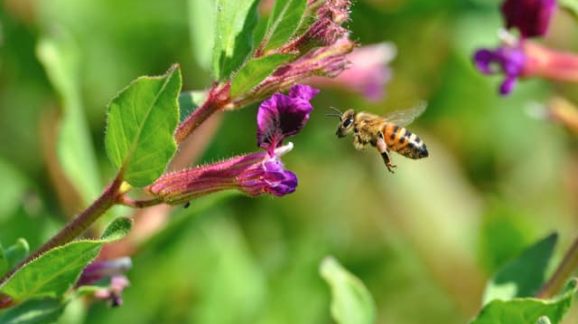“Beepocalypse” Not
Honeybee Claims Collapse Under Scrutiny

Concern about the survival of the European honeybee has blossomed into a media frenzy during the past several years and activists have declared, “Beepocalypse”! Beekeepers have seen see some of their honey bee hives disappear in recent years, and concerned observers have blamed the losses on everything from cell phones to genetically modified crops. The most frequently alleged culprit, though, is a class of pesticides known as neonicotinoids. But such alarmism is not supported by the facts. This parade of alarming news stories has led the European Union to place a moratorium on neonicotinoids, and U.S. policymakers are considering similar options. Such bans and restrictions will do more harm than good as more toxic chemicals replace neonicotinoids. This paper aims to sort fact from fiction and promote a more balanced understanding that will facilitate rational solutions for helping honeybees. It shows:
Colony Collapse Disorder is not the biggest threat facing honeybees. Lots of people blame hive losses in recent years on the so-called Colony Collapse (CCD) disorder, a phenomenon in which worker bees disappear, leaving behind the queen and honey. But according to a 2010 United Nations study, about 7 percent of hive losses are attributed to CCD, and the remaining 93 percent to other causes. In fact, the more significant problem is not really CCD, but instead compromised hive health, which is affected by a combination of factors, including: diseases and parasites, poor queen bee health, hive transport for pollination services, and nutritional issues. Pesticides are the least among these factors and neonicotinoids the least among those, if they have any impact at all.
CCD is not a new problem that can be easily attributed to modern pesticides. The mysterious disappearance of hives is not a new phenomenon. For example, the U. S. Department of Agriculture’s (USDA) Agricultural Research Service, points out similarly curious honeybee disappearances in the 1880s, 1920s, and 1960s.
Honeybees are not even a “natural” part of any ecosystem in the United States. A narrative popular among environmentalists suggests that the problem is mankind’s “tampering with nature,” but honeybees are not even “native” to the United States. Instead, they are a farmed agricultural commodity, imported from Europe during the 17th century for honey production and crop pollination. Like cattle, they are largely an agricultural commodity that is farmed and managed by human hands, in this case beekeepers.
Honeybees are nowhere near going extinct. In fact, the number of hives has increased globally. Globally, far more honeybees are used for honey production than pollination services, and the amount of honey produced has increased. U.S. and European commercial hives have decreased because honey production simply moved to other nations, where the number of hives have grown substantially. According to the United Nations Food Agricultural Organization (FAO) statistics the number of beehives kept globally has grown from nearly 50 million in 1961 to more than 80 million in 2013.
Surveys in 2014 show that honeybee hives have improving survival rates. Hives kept for pollination services in the United States and Europe have shown better survival rates in recent years, much closer to what beekeepers consider normal. This occurred despite continued use of neonicotinoids.
Farming and food production is not about to collapse because of poor pollination. About one third of food production in the United States benefits from honey bee pollination, according to USDA. Poor hive health is unlikely to completely undermine production of these foods, but it could make them more expensive. Fortunately, improved hive survival can mitigate such issues.
There is no consistent correlation between neonicotinoids and hive losses. If neonicotinoids were a cause of significant hive losses, we would expect to see at least some correlation between their use and high hive losses, but no such pattern has been observed since their introduction in the 1990s. In many places where these chemicals are used widely, such as in Australia, CCD is not a problem. And in Europe during 2013-2014, hives survived well in many areas where neonicotinoids were used.
Field studies find no health effects from “sublethal exposures” to neonicotinoids. To date, there are no studies showing that honeybees have suffered ill effects from “field-relevant” neonicotinoid exposures. Only studies that feed the bees unrealistically high levels of the chemicals show adverse effects. Studies of bees in the field where neonicotinoids are used show no measureable effects.
Neonicotinoids do not present the most significant pesticide exposure to honeybees. While activists like to blame neonicotinoids for the disappearance of hibernating bees, little of these chemicals is actually found in the hives. Instead, most of the chemicals found in the hive are put there by beekeepers trying to fight various diseases carried by mites and other organisms. “It’s like chemotherapy. They know it’s bad, but it’s a lot better than the alternative,” says bee researcher Dennis vanEngelsdorp.
Alternative chemicals may prove more dangerous than neonicotinoids. The U.S. Agricultural Research Service notes on its website: “The neonicotinoids were developed in the mid-1990s in large part because they showed reduced toxicity to honey bees, compared with previously used organophosphate and carbamate insecticides.” If farmers cannot use neonicotinoids, they will use other chemicals that are more toxic to bees.
Regulations will not solve the problem. Regulations are slow to develop, governed by political rather than practical and scientific goals, and hard to modify, even when they become counterproductive. In the case of honeybees, the best solutions will emerge with collaboration among the parties with an interest in protecting bees, including beekeepers, farmers and home gardeners.
Honeybee health issues are far broader than concerns raised by CCD alone and the solutions require a better understanding of the issue. Shortsighted pesticide bans will prove counterproductive, undermining food production and harming both honeybees and native pollinators because replacement products are likely to prove more dangerous. The best solution will strike a balance that recognizes the value of targeted and managed use of agrochemicals while minimizing risks.